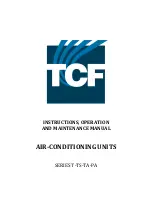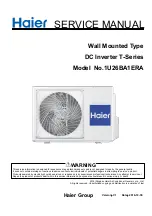
6
water stream to avoid damaging the fin edges. Monthly cleaning
as described below is recommended.
Routine Cleaning of Evaporator Coil Surfaces
Monthly cleaning with Totaline
®
environmentally balanced coil
cleaner is essential to extend the life of coils. This cleaner is avail
-
able from Carrier Replacement parts division as part number
P902-0301 for one gallon container, and part number P902-0305
for a 5 gallon container. It is recommended that all round tube coil
cleaner as described below. Coil cleaning should be part of the
unit’s regularly scheduled maintenance procedures to ensure long
life of the coil. Failure to clean the coils may result in reduced du
-
rability in the environment.
Avoid the use of:
• coil brighteners
• acid cleaning prior to painting
• high pressure washers
• poor quality water for cleaning
Totaline environmentally balanced coil cleaner is non-flammable,
hypoallergenic, non-bacterial, and a USDA accepted biodegrad
-
able agent that will not harm coil or surrounding components such
as electrical wiring, painted metal surfaces, or insulation. Use of
non-recommended coil cleaners is strongly discouraged since coil
and unit durability could be affected.
Totaline Environmentally Balanced Coil Cleaner Application
Equipment
• 2
1
/
2
gallon garden sprayer
• Water rinse with low velocity spray nozzle
Totaline Environmentally Balanced Coil Cleaner Application
Instructions
1. Proper eye protection such as safety glasses is recommended
during mixing and application.
2. Remove all surface loaded fibers and dirt with a vacuum
cleaner as described above.
3. Thoroughly wet finned surfaces with clean water and a low
velocity garden hose, being careful not to bend fins.
4. Mix Totaline environmentally balanced coil cleaner in a 2
1
/
2
gallon garden spryer according to the instructions included
with the cleaner. The optimum solution temperature is 100°F
(38°C).
NOTE: Do NOT USE water in excess of 130°F (54°C), as the en
-
zymatic activity will be destroyed.
1. Thoroughly apply Totaline environmentally balanced coil
cleaner solution to all coil surfaces including finned area, tube
sheets and coil headers.
2. Hold garden sprayer nozzle close to finned areas and apply
cleaner with a vertical, up-and-down motion. Avoid spraying
in horizontal pattern to minimize potential for fin damage.
3. Ensure cleaner thoroughly penetrates deep into finned areas.
4. Interior and exterior finned areas must be thoroughly cleaned.
5. Finned surfaces should remain wet with cleaning solution for
10 minutes.
6. Ensure surfaces are not allowed to dry before rinsing. Reap
-
ply cleaner as needed to ensure 10 minute saturation is
achieved.
7. Thoroughly rinse all surfaces with low velocity clean water
using downward rinsing motion of water spray nozzle. Pro
-
tect fins from damage from the spray nozzle.
Refrigerant System Pressure Access Ports
There are two access ports in the system - on the suction tube near
the compressor and on the discharge tube near the compressor.
These are brass fittings with black plastic caps. The hose connec
-
tion fittings are standard
1
/
4
-in. SAE male flare couplings.
The brass fittings are two-piece high flow valves, with a receptacle
base brazed to the tubing and an integral spring-closed check
valve core screwed into the base. (See Fig. 8.) This check valve is
permanently assembled into this core body and cannot be serviced
separately; replace the entire core body if necessary. Service tools
are available from RCD that allow the replacement of the check
valve core without having to recover the entire system refrigerant
charge. Apply compressor refrigerant oil to the check valve core’s
bottom O-ring. Install the fitting body with 96 ± 10 in-lb of torque;
do not overtighten.
Troubleshooting Cooling System
Refer to Table 1 for additional troubleshooting topics.
CAUTION
UNIT DAMAGE HAZARD
Failure to follow this caution may result in accelerated
corrosion of unit parts.
Harsh chemicals, household bleach or acid or basic cleaners
should not be used to clean outdoor or indoor coils of any kind.
These cleaners can be very difficult to rinse out of the coil and
can accelerate corrosion at the fin/tube interface where
dissimilar materials are in contact. If there is dirt below the
surface of the coil, use the environmentally balanced coil
cleaner.
CAUTION
UNIT DAMAGE HAZARD
Failure to follow this caution may result in reduced unit perfor
-
mance or unit shutdown.
High velocity water from a pressure washer, garden hose, or
compressed air should never be used to clean a coil. The force
of the water or air jet will bend the fin edges and increase air
-
side pressure drop.
Содержание 48LC 14
Страница 27: ...27 Fig 38 Integrated Gas Control IGC Board RED LED STATUS...
Страница 81: ...81 Fig B Typical Electromechanical Control Wiring Diagram 48LC 14 26 APPENDIX D WIRING DIAGRAMS...
Страница 82: ...82 Fig C 48LC 14 26 Systemvu Control Schematic APPENDIX D WIRING DIAGRAMS...
Страница 83: ...83 Fig D 48LC 14 26 RTU Open Control Wiring Diagram APPENDIX D WIRING DIAGRAMS...
Страница 85: ......







































